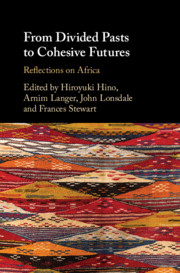Book contents
- From Divided Pasts to Cohesive Futures
- From Divided Pasts to Cohesive Futures
- Copyright page
- Contents
- Figures
- Tables
- Contributors
- Foreword
- Acknowledgments
- Introduction: Understanding Processes of Change in Social Cohesion: Learning from Comparative History
- Part I Social Cohesion in Africa: Case Studies of Past and Present
- 1 Kenya’s Four Ages of Ethnicity
- 2 Better Elections, More Deaths
- 3 Ethnicity, Citizenry, and Nation-Building in Tanzania
- 4 Identity, Inequality, and Social Contestation in the Post-Apartheid South Africa
- 5 Ethnicity, Development, and Social Cohesion in Africa
- Part II Policies and Institutions for Social Cohesion
- Part III Conclusions and Policy Recommendations
- Index
- References
4 - Identity, Inequality, and Social Contestation in the Post-Apartheid South Africa
from Part I - Social Cohesion in Africa: Case Studies of Past and Present
Published online by Cambridge University Press: 05 August 2019
- From Divided Pasts to Cohesive Futures
- From Divided Pasts to Cohesive Futures
- Copyright page
- Contents
- Figures
- Tables
- Contributors
- Foreword
- Acknowledgments
- Introduction: Understanding Processes of Change in Social Cohesion: Learning from Comparative History
- Part I Social Cohesion in Africa: Case Studies of Past and Present
- 1 Kenya’s Four Ages of Ethnicity
- 2 Better Elections, More Deaths
- 3 Ethnicity, Citizenry, and Nation-Building in Tanzania
- 4 Identity, Inequality, and Social Contestation in the Post-Apartheid South Africa
- 5 Ethnicity, Development, and Social Cohesion in Africa
- Part II Policies and Institutions for Social Cohesion
- Part III Conclusions and Policy Recommendations
- Index
- References
Summary
This chapter is about contestations in the South African society – its past, present and future. It provides historical accounts of formation of ethnic and race identities and offers some evidence that South Africans became less exclusive of people in other race groups during the early years of post-apartheid period, but have reversed this accomplishment over the last 10 years. The chapter then holistically examines inequality in the post-apartheid period; namely, at national level, between and within ethnic and race groups, and measured by income and by self-assessment of an individual’s life satisfaction. It identifies “inequality hot spots” on this basis, which need to be addressed if a more cohesive society is to be nurtured in the country. Finally, the chapter finds tentative signs of the emergence of a common citizenry, a national identity, which would also be needed for South Africa to transition to a cohesive society.
- Type
- Chapter
- Information
- From Divided Pasts to Cohesive FuturesReflections on Africa, pp. 123 - 160Publisher: Cambridge University PressPrint publication year: 2019



